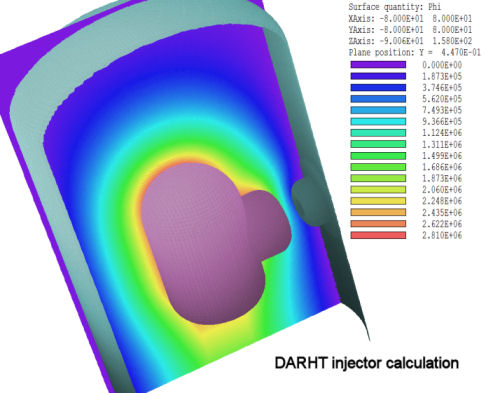Field Precision Achieves Unprecedented Speed in 3D Finite-element Software
20th August 2009
Source:
Field Precision LLC

Field Precision 3D high-speed FEM simulation programs have run times measured in minutes. Applications for Windows computers include high-voltage engineering, magnet design, electron guns and X-ray devices.
A prevailing view of three-dimensional finite-element software is that run times may extend from hours to days. Field Precision LLC has developed novel software technology to generate accurate results for real-world design problems in minutes. High-speed operation is the result of a combination of new approaches and common sense:
-- The MetaMesh program has the unique capability to generate structured, conformal meshes. Such meshes combine the accuracy of conformal elements with the efficiency of strict logical order where element relationships are determined by index operations.
-- The solution programs are written entirely in modern FORTRAN, a language unmatched for serious number crunching.
-- The design of the programs scrupulously avoids stratagems like object-oriented programing that make coding easier but add computational overhead.
-- Instead of using generalized libraries, mathematical routines are hand-coded for top efficiency. The programs are carefully analyzed to remove redundancies and to minimize disk access.
-- The solution techniques are chosen to involve the fewest operations and to make minimum demands on memory (e.g., the scalar reduced-potential method for 3D magnetic field calculations).
The end result of this effort is to make three-dimensional simulations practical, even on ordinary personal computers. The performance can be illustrated with an electrostatic calculation, the injector for the DARHT Accelerator at Los Alamos National Laboratory. The challenge is to model the full volume of a 6.3 m high vacuum chamber while achieving sufficient accuracy to calculate transport of a space-charge-limited relativistic electron beam across an acceleration gap. For a realistic test, the calculation was not performed on an expensive, optimized workstation. Instead, we used an off-the-shelf $600 HP computer (Windows Vista 64, Intel Core2 Duo E8400 at 3.00 GHz). The mesh (with 1.75 million elements) took 18 seconds to create with MetaMesh. The finite-element solution with the HiPhi program involved the generation and matrix inversion of a set of close to 2 million node equations. The total run time was under 5 minutes (287 seconds), barely time to get a cup of coffee. With such short run times, users have the latitude to do what-if experiments and to investigate a wider range of parameters and approaches.
-- The MetaMesh program has the unique capability to generate structured, conformal meshes. Such meshes combine the accuracy of conformal elements with the efficiency of strict logical order where element relationships are determined by index operations.
-- The solution programs are written entirely in modern FORTRAN, a language unmatched for serious number crunching.
-- The design of the programs scrupulously avoids stratagems like object-oriented programing that make coding easier but add computational overhead.
-- Instead of using generalized libraries, mathematical routines are hand-coded for top efficiency. The programs are carefully analyzed to remove redundancies and to minimize disk access.
-- The solution techniques are chosen to involve the fewest operations and to make minimum demands on memory (e.g., the scalar reduced-potential method for 3D magnetic field calculations).
The end result of this effort is to make three-dimensional simulations practical, even on ordinary personal computers. The performance can be illustrated with an electrostatic calculation, the injector for the DARHT Accelerator at Los Alamos National Laboratory. The challenge is to model the full volume of a 6.3 m high vacuum chamber while achieving sufficient accuracy to calculate transport of a space-charge-limited relativistic electron beam across an acceleration gap. For a realistic test, the calculation was not performed on an expensive, optimized workstation. Instead, we used an off-the-shelf $600 HP computer (Windows Vista 64, Intel Core2 Duo E8400 at 3.00 GHz). The mesh (with 1.75 million elements) took 18 seconds to create with MetaMesh. The finite-element solution with the HiPhi program involved the generation and matrix inversion of a set of close to 2 million node equations. The total run time was under 5 minutes (287 seconds), barely time to get a cup of coffee. With such short run times, users have the latitude to do what-if experiments and to investigate a wider range of parameters and approaches.
Similar articles
More from Field Precision LLC
- Field Precision announces new capability: 3D meshes from photographs 8th September 2011
- Field Precision announces Associates program for consultants and small businesses 16th August 2011
- Field Precision releases GamBet 3.0, multicore Monte Carlo software 2nd March 2011
- Field Precision Releases TriComp 7.0 for E&M fields and Electron Guns 22nd September 2010




 technology at Jacobs Vehicle Systems.JPG)







Write a comment
No comments